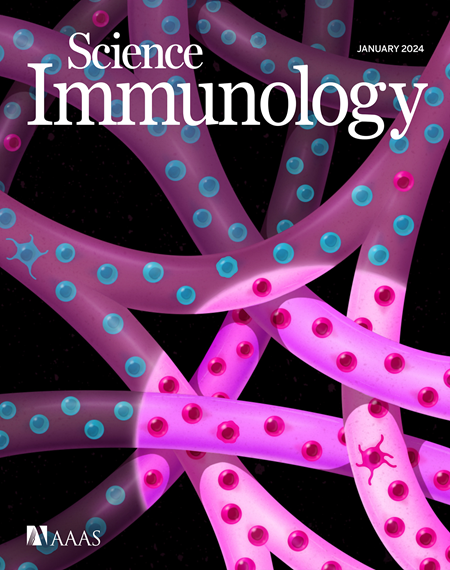Allergen-induced airway matrix remodeling in mice can be prevented or reversed by targeting chitinase-like proteins
IF 16.3
1区 医学
Q1 IMMUNOLOGY
引用次数: 0
Abstract
Chitinase-like proteins (CLPs) are established biomarkers of inflammation and airway remodeling in asthma, yet their direct contribution toward disease pathogenesis is unknown. In a mouse model of type 2/type 17 airway inflammation induced by house dust mite, ragweed, and Aspergillus fumigatus (DRA) allergens, we demonstrate that murine CLPs Ym1 (Chil3) and Ym2 (Chil4) exert distinct and potent effects on airway extracellular matrix (ECM) composition during chronic lung pathology. Using both Ym1-knockout (Chil3−/−) and Ym2-knockdown (Chil4KD/KD) mice, we found that these CLPs have fundamental roles in airway remodeling that are independent of interleukin-13 (IL-13) and IL-17A signaling pathways. Antibody-mediated inhibition of CLPs after pathology has developed reverses airway remodeling independently of chronic inflammation. However, this inhibition is not sufficient to reduce airway hyperresponsiveness (AHR) in allergic animals. Instead, the absence of CLPs increases epithelial damage and leads to a loss of bronchial epithelial integrity. This work disentangles chronic IL-13 and IL-17A signaling from the development of allergic airway pathology and reveals CLPs as orchestrators of airway remodeling that can produce both protective and adverse outcomes.
几丁质酶样蛋白可以预防或逆转小鼠变应原诱导的气道基质重塑
几丁质酶样蛋白(CLPs)是哮喘炎症和气道重塑的生物标志物,但其对疾病发病机制的直接作用尚不清楚。在尘螨、豚草和烟曲霉(DRA)过敏原诱导的2/ 17型气道炎症小鼠模型中,我们证明了小鼠CLPs Ym1 (Chil3)和Ym2 (Chil4)在慢性肺病理过程中对气道细胞外基质(ECM)组成有明显而有效的影响。通过使用ym1敲除(Chil3−/−)和ym2敲除(Chil4 KD/KD)小鼠,我们发现这些CLPs在气道重塑中具有独立于白细胞介素-13 (IL-13)和IL-17A信号通路的基础作用。病理后抗体介导的CLPs抑制已发展为独立于慢性炎症的逆转气道重塑。然而,这种抑制不足以减少过敏动物的气道高反应性(AHR)。相反,CLPs的缺失会增加上皮损伤并导致支气管上皮完整性的丧失。本研究揭示了慢性IL-13和IL-17A信号与过敏性气道病理发展的关系,并揭示了CLPs作为气道重塑的协调者,可以产生保护性和不良后果。
本文章由计算机程序翻译,如有差异,请以英文原文为准。
求助全文
约1分钟内获得全文
求助全文
来源期刊

Science Immunology
Immunology and Microbiology-Immunology
CiteScore
32.90
自引率
2.00%
发文量
183
期刊介绍:
Science Immunology is a peer-reviewed journal that publishes original research articles in the field of immunology. The journal encourages the submission of research findings from all areas of immunology, including studies on innate and adaptive immunity, immune cell development and differentiation, immunogenomics, systems immunology, structural immunology, antigen presentation, immunometabolism, and mucosal immunology. Additionally, the journal covers research on immune contributions to health and disease, such as host defense, inflammation, cancer immunology, autoimmunity, allergy, transplantation, and immunodeficiency. Science Immunology maintains the same high-quality standard as other journals in the Science family and aims to facilitate understanding of the immune system by showcasing innovative advances in immunology research from all organisms and model systems, including humans.
 求助内容:
求助内容: 应助结果提醒方式:
应助结果提醒方式:


